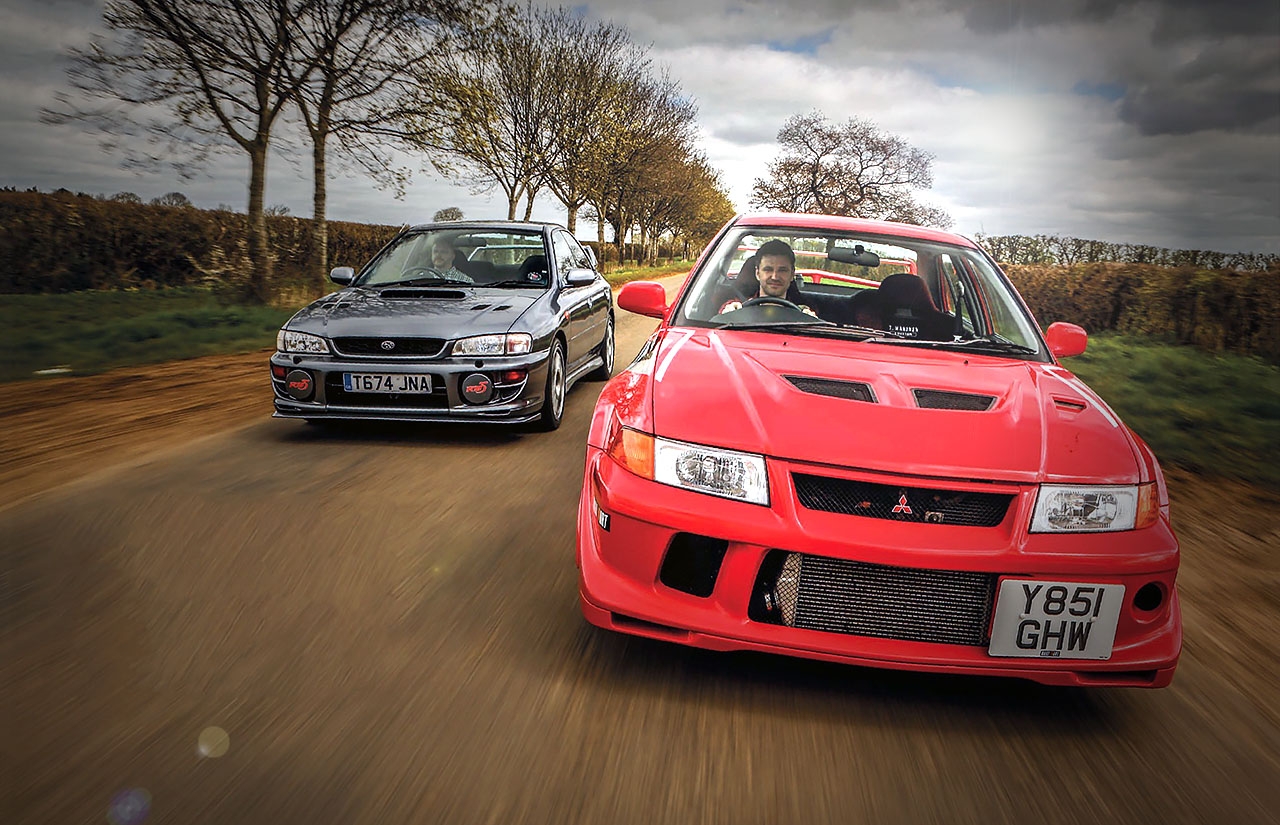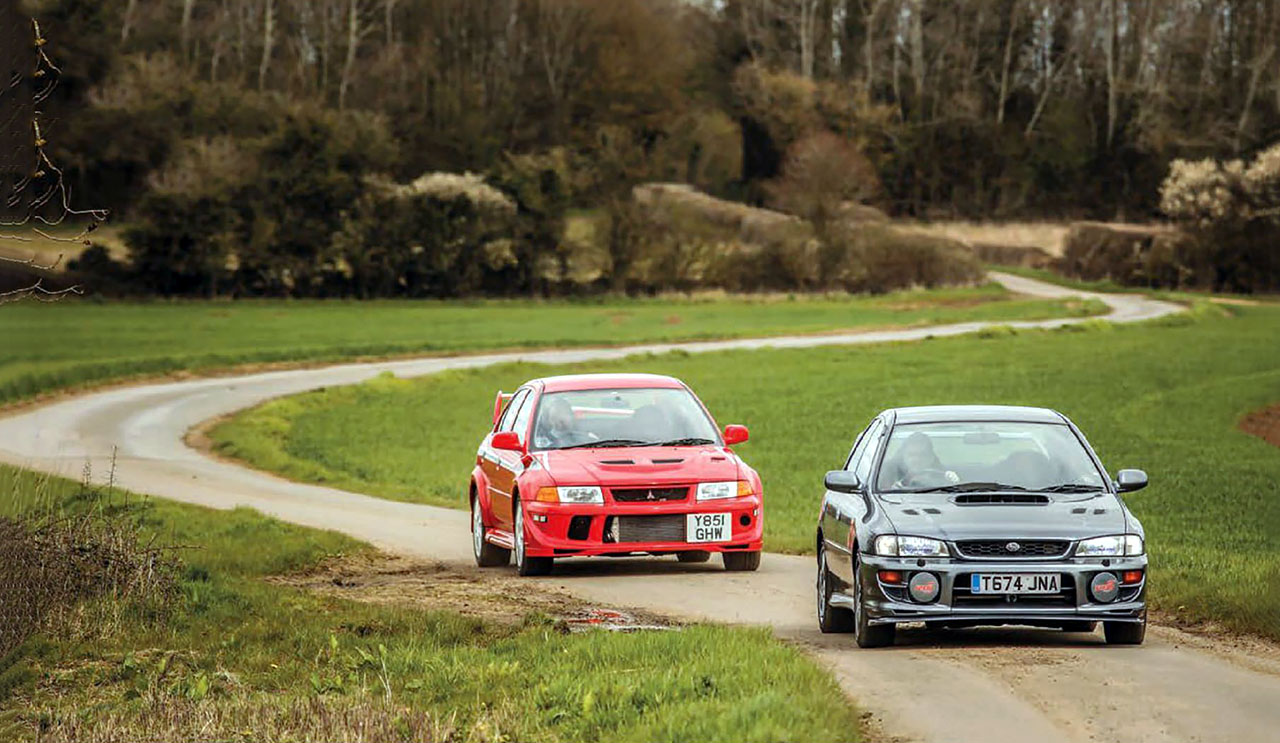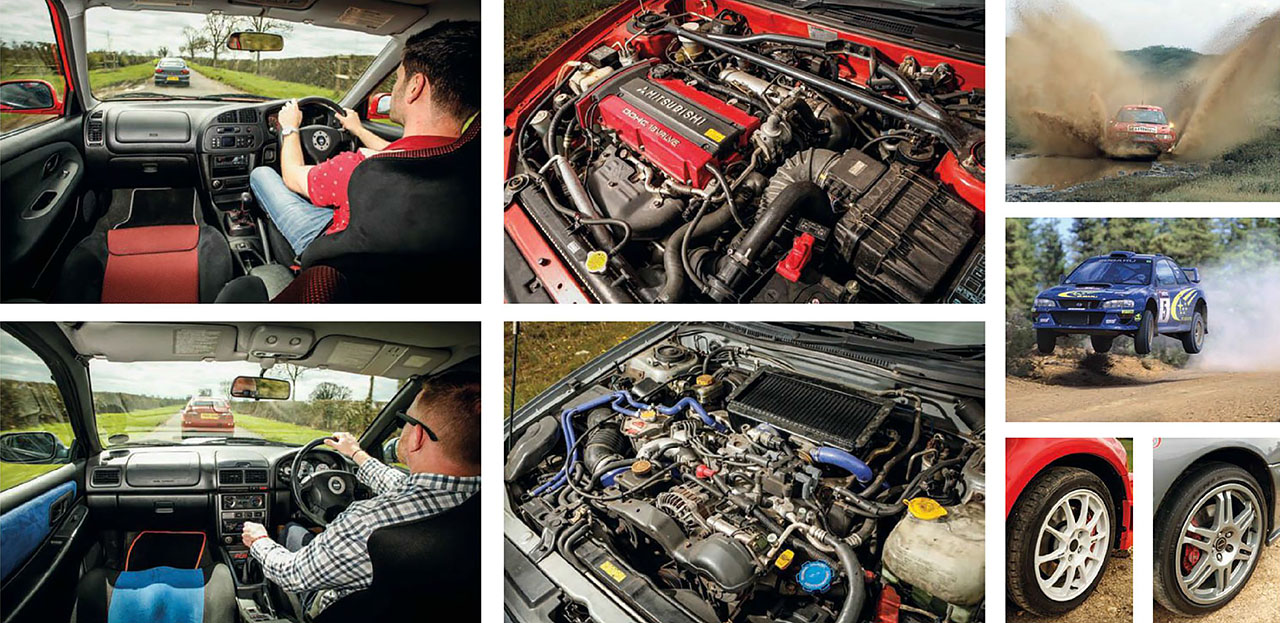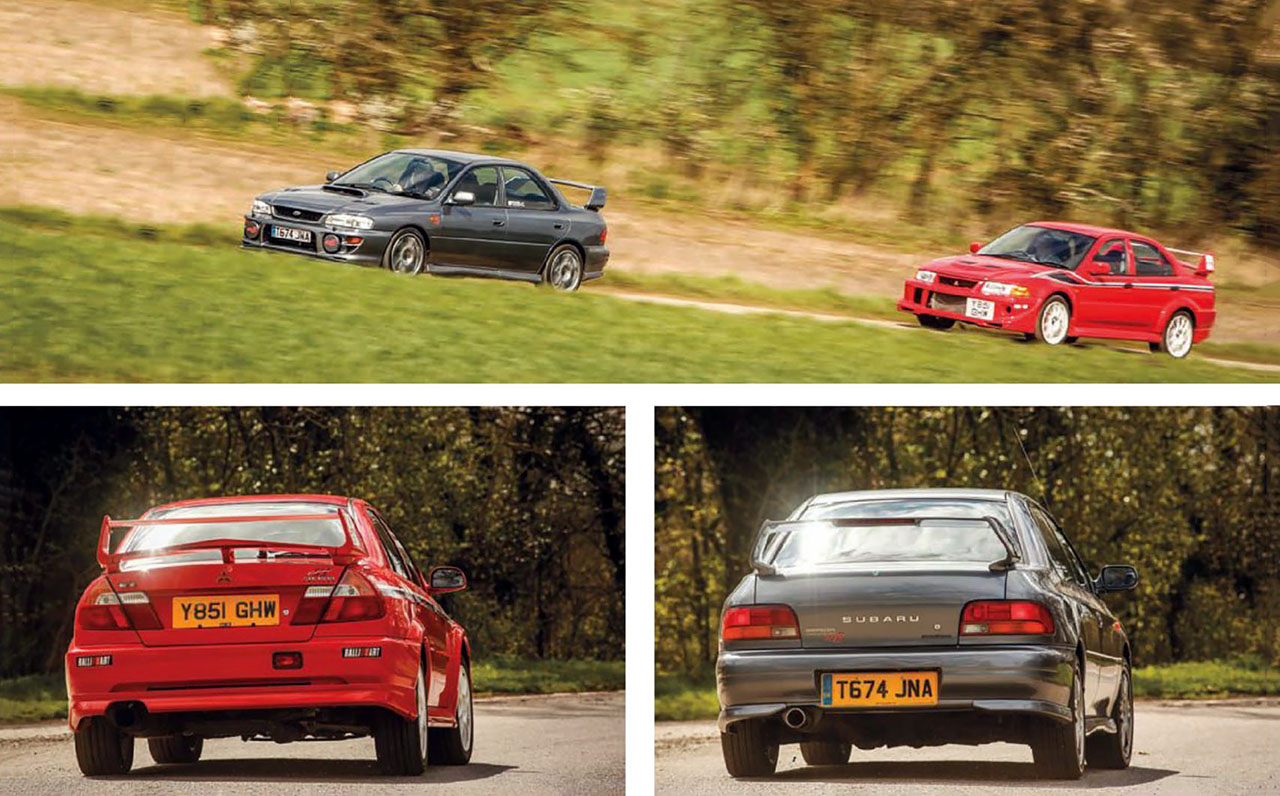
Stage fight Subaru Impreza vs. Mitsubishi Evo Rally Icons. Charting the rise of the Japanese supersaloon by pitching Subaru Impreza against Mitsubishi Evo. Conceived to lock horns in rallying, the Subaru Impreza and Mitsubishi Evo were two of the hottest ’90s saloons but which is the better drive today? Greg MacLeman finds out. Photography Tony Baker.
Forget Rangers and Celtic, Coca-Cola and Pepsi, or Take That and Boyzone. The biggest head-tohead of the 1990s came from the land of the rising sun, the world’s gravel-strewn special stages and every McDonalds car park from Basildon to Bognor Regis: Impreza vs Evo.
Like the greatest rivalries, theirs was the result of similarity rather than difference. Mitsubishi and Subaru had been contenders in rallying since the 1970s and ’80s, and both had built up a reputation for success. Works Lancers took the first four places on the 1973 Southern Cross Rally, plus a win on the ’74 East African Safari – followed by a 1-2-3 on the same event two years later. Subaru, meanwhile, built on its Group 1-winning East African Safari debut with a Group 2 win in 1983. By the early ’90s, both firms were targeting the World Rally Championship title, and the engineering nous gained from years of campaigning their cumbersome four-wheel-drive Galant and Legacy models enabled them to create homologation specials perfectly suited to the task.

From top: air intakes abound, giving both shapes an aggressive demeanour; Tommi Mäkinen heading for Safari victory in 2001; Richard Burns gets airborne on his way to a win in Australia in 1999.
It was against this backdrop in late 1992 that Mitsubishi’s first Lancer Evolution broke cover in Japan. It was equipped with a turbocharged 1997cc dohc ‘four’ capable of producing 250bhp, mated to a centre viscous coupling four-wheel-drive system. Only 2500 needed to be sold to qualify the car for international competition, but demand was so strong that a further 2500 were quickly entered into production.
Subaru’s response came just a few weeks later in the form of the Japanese-market Impreza, a four-door saloon built around a 1994cc EJ20 version of the Legacy’s venerable flat-four – fitted, ironically, with a Mitsubishi TD04H turbocharger. With a power output of 240bhp, the new Subaru went toe-to-toe with the Lancer.
It wasn’t until they fell into the hands of messrs McRae and Mäkinen that the real revolution of these supersaloons was appreciated outside of Japan. Both cars were in action alongside their older compatriots from ’93 but it took until 1995 for first blood to be drawn, when Subaru took the Drivers’ and Constructors’ championships thanks to the utterly committed ‘flat out and fearless’ Colin McRae. The sight and sound of the blue and yellow 555-liveried Scoobies popping and banging through forest stages sparked the imagination of British buyers, who flocked to the showroom.
Mitsubishi’s success followed, in altogether more emphatic fashion: Finnish ace Tommi Mäkinen emulated McRae’s success in 1996, ’97, ’98 and ’99, each time showcasing the latest and greatest model – from Evo III through to Evo VI. It was the Finn’s fourth consecutive championship victory that inspired the ultra-desirable Tommi Mäkinen Edition, of which just 2500 examples were built. In the meantime, Subaru driver Richard Burns had impressed by winning the British Rally Championship at the wheel of a Legacy, finishing third on the 1995 RAC and in the process becoming the inspiration behind a special-edition Impreza – the RB5 – of which 444 examples were offered to the British public.

Typically ’90s black plastic dominates the cabins, but brightly coloured bucket seats provide a visual lift as well as clamping you firmly in place on bends. Both cars are powered by multivalve turbocharged ‘fours’, but where the Evo relies on a conventional transverse in-line unit, the Subaru has a boxer.
Whether as a result of strict entry regulations for the All-Japan Grand Touring Championship or a gentlemen’s agreement – debate still rages – Imprezas and Evos both had an output of 276bhp in the ’90s, which is the figure produced by ‘our’ Tommi Mäkinen Edition. The Evo VI had been on sale in the UK since 1999 – the first version to be officially imported and sold here – while the TME arrived in ’01 with a number of key differences.
The most obvious were external, including an aggressive front spoiler and white Enkei alloys aping those of the works cars. It sat lower, too, thanks to rock-hard tarmac-stage suspension, while under the bonnet was a titanium turbo.
Japanese-market Imprezas offered comparable performance, but the Turbo 2000 that was sold here – of which the RB5 is a variant – produced a less earth-shattering 218bhp. Many RB5s were specified in WR Sport trim and came equipped with the Prodrive Performance Pack (PPP), a dealer option offered by Subaru’s World Rally Championship team operator that included uprated centre and rear stainless-steel exhaust silencers, a quick-shift gearchange and – crucially – a remapped ECU that helped boost peak output to 238bhp. Lift the passenger carpet and you’ll find the box adorned with the pink go-faster lettering of the firm’s tuning arm – Subaru Tecnica International. All 444 RB5s were finished in Blue Steel with colour-coded mirrors, door handles, skirts and driving lamp covers, in addition to 17in six-spoke Speedline alloys, blue Alcantara and suede trim, plus air-conditioning.
What the RB5 gives away in out-and-out power it claws back on the scales. Biscuit-tin-like panels and a spartan interior contribute to a kerb weight of just 1235kg – 125kg lighter than the gizmo-laden Lancer. Does the equivalent of two (all right, one and a half) motoring journalists tell on the road? Well, yes. Despite being down on power to the tune of nearly 30bhp (and it feels as if the Mitsubishi’s 276bhp is a pessimistic figure) the Subaru seems to hold its own in the acceleration stakes, only suffering from noticeable lag at very low revs and appearing eager to spin up to the national limit. It’ll get you there in just over 5.5 secs with the wind behind you, and all without leaving second gear. Beyond that, though, it begins to run out of puff, needing an extended breather before eventually reaching its top speed of 141mph.
Although the Evo VI is marginally heavier, its sheer power tells in a straight line, allowing it to cover the same 0-60mph dash 0.8 secs quicker than the RB5. But it’s in the corners that the TME really begins to pull away. Where the Impreza’s four-wheel-drive system feels reassuringly mechanical, the Evo gives the impression of an electronic brain with wheels. An incredibly clever active yaw control system – in essence a computer-controlled differential – senses when the car is losing traction and redistributes power to each wheel accordingly. Think of it as Deep Blue to the Impreza’s Kasparov. The result is a car that feels otherworldly in its levels of grip. However hard you try to unsettle it, the Evo just clings on, the electronic synapses firing a thousand times quicker than those of the driver.

Clockwise: softer shape of Impreza has aged better than that of its Mitsubishi rival; vast rear wings and four-wheel drive ensure astonishing levels of grip.
The RB5 doesn’t have the same astonishing performance as the Mitsubishi, but it is every bit as enjoyable to throw down the road. The limits of its grip are much easier to find thanks to the less intelligent four-wheel-drive system and also the tyres, which are 20mm narrower than the Evo’s and make the car feel lively and nimble. The gearbox, too, is more intuitive. It doesn’t like to be rushed, but offers a smoother action than the notchy ’box in the younger car.
The Mitsubishi has the facts and figures all sewn up, but it’s in the less quantifiable areas that it once again loses ground to the Scooby. Beauty, for example. Neither car is in danger of being displayed in the Museum of Modern Art, but the general consensus during our shoot is that the Impreza’s better-proportioned, smoother shell has aged more gracefully. Both firm’s budgets must have been blown on the exterior design, though, because neither is particularly pleasant inside. The Evo has the nicer seats, but beyond that there’s little to recommend one sea of black plastic over the other. In fact, cover up the Momo wheel and you’d be hard pressed to differentiate the TME from any repmobile of the era.
But then there’s the noise. That noise. That unmistakable Impreza burble that pricks up sleeping owners’ ears as it stalks through the night. It holds clear purpose – almost menace – and endows the Subaru with a character that is starkly lacking in the Evo. The Prodrive pipe has real bark, whereas the Lancer – despite boasting an exhaust so large you could get your head stuck in it – sounds like a washing machine on a spin cycle. Ultimately, though, it’s the legacy of accessible performance that still draws in fans today.
When the original Evo went on sale in Japan in 1992, the only Ferraris quicker to 60mph were hyper-exclusive specials, such as the F40 and 288GTO. In the UK, the Impreza comfortably outpaced Ford’s performance milestone Escort Cosworth – and for £5k less than its competitor.
With more powerful saloons beyond the reach of the average buyer, Subaru broke the mould by offering its rally rocket for a list price of £17,499. The years have rolled on, but both Evo VI and Impreza still offer incredible value for money. The former can be found for about £10k, and at that price it can be considered an investment.
Prices have bottomed out and, although not hugely rare, that means it’s still within the grasp of most of us. The Impreza is even cheaper. ‘Our’ RB5 is on the market for £8k and, though undoubtedly worth every penny, a standard Turbo 2000 fitted with the Prodrive Performance Pack looks even better value – prices for good cars start at £4k. If exclusivity and resale value are on your wish list, look no further than the P1 – aside from the supercar-money 22B, the only two-door version officially sold in the UK. Modern classic? Future classic?
Youngtimer? Whichever descriptor you use, it’s clear that the Subaru Impreza and Mitsubishi Lancer Evolution were true game-changers.
The Tommi Mäkinen Edition Evo is undeniably the best of the breed, bringing together scintillating performance in a beautifully balanced package that offers a more electrifying drive than its forebears or its flabby descendants. The Impreza, meanwhile, impresses in its original form. Feather-light, rugged and clothed in a body that has aged better than the Optimus Prime-style TME, it captures the same level of design purity as those other genesis models, the Mk1 Golf GTI and Mazda MX-5.
With cars so closely related that their progeny would have webbed feet, is it possible to choose one over the other? As a point-to-point sprinter you can’t look beyond the Evo. Even 17 years on, it remains one of the quickest and easiest to drive supersaloons ever built. But it’s the Impreza that more comfortably wears its classic credentials. It may be slower, but it’s more engaging at anything less than ten-tenths, and has the character to captivate long after the novelty of its blistering pace has worn thin.
Thanks to Mitsubishi Motors UK; Xclusive Motorz: 07446 666006
The rivals
NISSAN SKYLINE R33
The fourth-generation Skyline joined the fray in ’95 and featured a trick all-wheel-drive system with an active limited-slip diff. It tips the scales at a weighty 1540kg, but its 2.6- litre twin-turbo ‘six’ – a thing of engineering beauty – is capable of getting it to 60mph in just 5 secs and on to a dizzying top speed of 155mph. They are an appreciating asset today, so you’ll need at least £10,000 in your back pocket.
MITSUBISHI 3000GT
Like the Nissan, the 3000GT was a technological tour de force packed with electronic wizardry that included four-wheel steering and active aerodynamics. Its blown 24-valve V6 was good for 276bhp-plus, and Americans even got a Spyder. None of those were officially imported here, but the coupé was. There are plenty still around, with the best costing over £10k. Grey imports sport the GTO moniker and are cheaper.
TOYOTA CELICA GT-FOUR
Like the Impreza and Evo, the Celica GT-Four was a homologation special destined for the World Rally Championship – only it got there much earlier. Toyota was the first Japanese marque to enter a turbocharged all-wheel-drive car in the series, where it met with much success. The firm clinched the title in 1990, 1992, 1993 and 1994. Look out for the rare Carlos Sainz Limited Edition.
‘THE IMPREZA FEELS MECHANICAL, BUT THE EVO IS AN ELECTRONIC BRAIN WITH WHEELS‘
|
Mitsubishi EVO VI TME Sold/number built 1999-2001/2500 Construction steel monocoque Engine all-alloy, dohc, 16v 1997cc turbocharged ‘four’ Max power 276bhp @ 6500rpm Max torque 275lb ft @ 2750rpm Transmission five-speed manual, four-wheel drive by centre viscous coupling with anti-yaw Suspension independent front MacPherson struts rear multi-link axle; coil springs, telescopic dampers, anti-roll bar f/r Brakes ventilated discs, four-pot calipers Wheels and tyres 17×7, 225/45R17 Length 14ft 3in (4350mm) Width 5ft 10in (1770mm) Height 4ft 7in (1400mm) Weight 2996lb (1360kg) 0-60mph 4.8 secs Top speed 150mph Price new £32,995 Price now £10,000+ |
Subaru Impreza RB5 Sold/number built 1999/444 Construction steel monocoque Engine all-alloy, dohc-per-bank, 16-valve 1994cc turbocharged flat-four Max power 238bhp @ 6000rpm Max torque 258lb ft @ 3500rpm Transmission five-speed manual, four-wheel drive by centre viscous coupling Suspension independent, MacPherson struts, telescopic dampers, anti-roll bar f/r Brakes ventilated discs all round Wheels and tyres 17×7, 205/45R17 Length 14ft 3in (4350mm) Width 5ft 7in (1690mm) Height 4ft 7in (1400mm) Weight 2723lb (1235kg) 0-60mph 5.6 secs Top speed 141mph Price new £24,995 (£27,545 with Prodrive Performance Pack) Price now £6000+ |
{CONTENTPOLL [“id”: 64]}





